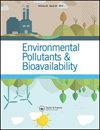Interface interactions between insecticide carbofuran and tea waste biochars produced at different pyrolysis temperatures
Q3 Chemical Engineering
引用次数: 36
Abstract
Abstract Biochars showed a potential as adsorbents for organic contaminants, however, have not been tested for carbofuran, which has been detected frequently in water. This study provides evidences for the use of infused tea residue derived biochar for carbofuran removal. Biochars were produced at 300, 500 and 700 °C by slow pyrolysis and were characterized by proximate and ultimate analysis, FT-IR, SEM, BET and pore size distribution. Pyrolysis temperature showed a pronounced effect on biochar properties. The maximum carbofuran removal was achieved at pH 5. Freundlich and Temkin models best fit the equilibrium data. Biochars produced at 700 °C showed the highest sorption intensity. The adsorption process was likely to be a favorable chemisorption process with electrostatic interactions between carbofuran molecules and biochar surface. Acid-base interactions, electrophilic addition reactions and amide bond formations are the possible mechanisms of carbofuran adsorption. Overall, biochars prepared from tea waste can be utilized as effective adsorbents for removal of aqueous carbofuran.不同热解温度下杀虫剂呋喃与茶废生物炭的界面相互作用
生物炭显示出作为有机污染物吸附剂的潜力,然而,尚未对水中经常检测到的呋喃进行测试。本研究为茶渣浸渍生物炭脱除呋喃提供了依据。在300、500和700°C慢热解条件下制备生物炭,并通过近似和极限分析、FT-IR、SEM、BET和孔径分布进行表征。热解温度对生物炭的性质有显著影响。pH值为5时,呋喃去除率最高。Freundlich和Temkin模型最适合均衡数据。在700℃生产的生物炭具有最高的吸附强度。吸附过程可能是呋喃分子与生物炭表面静电相互作用的有利化学吸附过程。酸碱相互作用、亲电加成反应和酰胺键形成是呋喃吸附的可能机理。综上所述,茶渣制备的生物炭可作为去除水中呋喃的有效吸附剂。
本文章由计算机程序翻译,如有差异,请以英文原文为准。
求助全文
约1分钟内获得全文
求助全文
来源期刊
CiteScore
1.62
自引率
0.00%
发文量
0
审稿时长
1 months
期刊介绍:
Chemical Speciation & Bioavailability ( CS&B) is a scholarly, peer-reviewed forum for insights on the chemical aspects of occurrence, distribution, transport, transformation, transfer, fate, and effects of substances in the environment and biota, and their impacts on the uptake of the substances by living organisms. Substances of interests include both beneficial and toxic ones, especially nutrients, heavy metals, persistent organic pollutants, and emerging contaminants, such as engineered nanomaterials, as well as pharmaceuticals and personal-care products as pollutants. It is the aim of this Journal to develop an international community of experienced colleagues to promote the research, discussion, review, and spread of information on chemical speciation and bioavailability, which is a topic of interest to researchers in many disciplines, including environmental, chemical, biological, food, medical, toxicology, and health sciences.
Key themes in the scope of the Journal include, but are not limited to, the following “6Ms”:
Methods for speciation analysis and the evaluation of bioavailability, especially the development, validation, and application of novel methods and techniques.
Media that sustain the processes of release, distribution, transformation, and transfer of chemical speciation; of particular interest are emerging contaminants, such as engineered nanomaterials, pharmaceuticals, and personal-care products.
Mobility of substance species in environment and biota, either spatially or temporally.
Matters that influence the chemical speciation and bioavailability, mainly environmentally relevant conditions.
Mechanisms that govern the transport, transformation, transfer, and fate of chemical speciation in the environment, and the biouptake of substances.
Models for the simulation of chemical speciation and bioavailability, and for the prediction of toxicity.
Chemical Speciation & Bioavailability is a fully open access journal. This means all submitted articles will, if accepted, be available for anyone to read, anywhere, at any time. immediately on publication. There are no charges for submission to this journal.

 求助内容:
求助内容: 应助结果提醒方式:
应助结果提醒方式:


